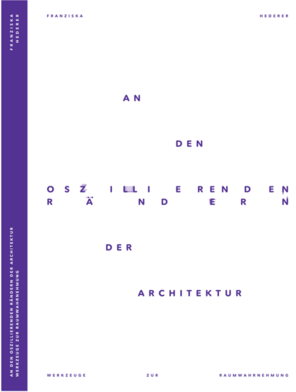
Franziska Hederer (2015), At the Oscillating Boundaries of Architecture: Tools for Spatial Perception, Institute of Spatial Design
Committee: Hans Gangoly, Irmgard Frank, Petra Petersson, Daniel Gethmann, Benjamin Schmid
266 pages, German.
The primary topic of the habilitation thesis At the Oscillating Boundaries of Architecture: Tools for Spatial Perception is the scientific-artistic subject “Spatial Perception and Experimental Design” as a subfield of spatial design. Spatial perception is the basic foundation for any kind of architectural design. It is a research activity that explores space. The density and intensity of the built space is influenced by how well attunded the perceptual sensorium proves to be.
At the heart of the investigation here is the immediate act of experiencing and assimilating space based on this hypothesis: “There is no such thing as detachment; we are always involved.” From this involved perspective it is possible to methodologically adopt implicit knowledge about space that impacts and partially determines diverse design decisions over time. In applied spatial experiements that work with the artistic method of the performative, there is an approximation of spatial dimensions like confinement and expanse, rhythm and dynamism, light and shadow, density and vacuity, the materiality of space, but also its vibrant structures. The person doing the perceiving, by directly interacting with the space, obtains an overview of the overall spatial context. This pertains not only to the built structures, but also lends a sense of perception to the space in its superordinate role as living site, to which interpersonal relationships and spaces of agency are inherent in particular. Moods and atmospheres of spatial constellations are detected using performative methods and explored as to their ability to become effective. Using various practices of engaging with space, the perceptual sensorium is developed and sensitized. The essential moment of such performative practices lies in the tracing of proportionalities and relations between the entities involved in the space. Demarcations play a vital role here, as does the disolution of boundaries, allowing something new to arise and something unknown to manifest which enriches the treasure of perception and thus also expands knowledge about the space from an experiential base.
The subject “Spatial Perception and Experimental Design” is theoretically accompanied by actor-network theory as described by Bruno Latour. In these theoretical reflections, he asserts a concept of space which is related to the social-spatial context and which presupposes a network and also interaction between people, things, and concerns in space. This is a spatial concept that not only references the static moments of the objectively tangible built space, but also operates with the dynamics, discontinuities, and variability of the spatial fabric, viewing space as possessing sociocultural magnitude. His theory, which evinces a strongly action-oriented aspect of practice, is closely proximate to the performative designing of spaces when it comes to methodology. Performance, in which the perceiving subject himself is entangled, is a means of arriving at a better, more comprehensive understanding of space and of developing independent thought about space. One obtains a new and changed perception of everyday life. In architecture, which serves as a space for rendering representation and continuity, this conception of space has hardly gained a foothold since it lacks stability and reliability. At the same time, it carries within itself the potential to spawn new and unknown aspects, which holds causal relevance for design processes and thus ultimately also for the buildings being designed. To that effect, spatial perception is to be understood as a research method that operates through performative means, forming a foundation for design activity. The thesis itself is conceived as a kind of “tool collection” for design processes that are based on the experiencing of one’s own body in space. This experiential knowledge is placed in correlation with theoretical conceptions of space, which consider it to be a space for exploration and a field of potentiality. If we assume that perception-based design processes deal with the mutual approximation of practice and theory, then this habilitation work offers opportunities and ideas for precisely this approximation. It is positioned at the junction between science and art, making a contribution to foundational research in the area of practice- and arts-based research.
